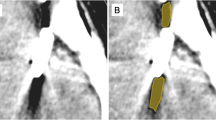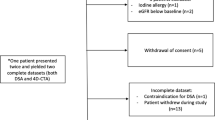Abstract
It is difficult to accurately understand the angioarchitecture of cerebral arteriovenous malformations (CAVMs) before surgery using existing imaging methods. This study aimed to evaluate the ability of the stereoscopic virtual reality display system (SVRDS) to display the angioarchitecture of CAVMs by comparing its accuracy with that of the conventional computed tomography workstation (CCTW). Nineteen patients with CAVM confirmed on digital subtraction angiography (DSA) or during surgery were studied. Computed tomography angiography images in the SVRDS and CCTW were retrospectively analyzed by two experienced neuroradiologists using a double-blind method. Angioarchitectural parameters, such as the location and size of the nidus, type and number of the arterial feeders and draining veins, and draining pattern of the vessels, were recorded and compared. The diameter of the nidus ranged from 1.1 to 9 cm. Both CCTW and SVRDS correctly diagnosed the location of the nidus in 19 patients with CAVM. Among the 19 patients, 35 arterial feeders and 25 draining veins were confirmed on DSA and during surgery. With the DSA and intraoperative results as the gold standard bases, the CCTW misjudged one arterial feeder and one draining vein and missed three arterial feeders and two draining veins; meanwhile, the SVRDS missed only two arterial feeders. SVRDS had some advantages in displaying nidus, arterial branches, and draining veins of the CAVM compared with CCTW, as well as SVRDS could more intuitively display the overall angio-architectural spatial picture of CAVM.




Similar content being viewed by others
Availability of Data and Materials
Data in this study is available from the corresponding author upon reasonable request.
Abbreviations
- CAVMs:
-
Cerebral arteriovenous malformations
- CTA:
-
Computed tomography angiography
- CCTW:
-
Conventional computed tomography workstation
- DSA:
-
Digital subtraction angiography
- MRA:
-
Magnetic resonance angiography
- SVRDS:
-
Stereoscopic virtual reality display system
- 3D:
-
Three-dimensional
- VR:
-
Volume rendering
References
Mosimann PJ, Chapot R: Contemporary endovascular techniques for the curative treatment of cerebral arteriovenous malformations and review of neurointerventional outcomes. J Neurosurg Sci 62:505–513, 2018
Stapf C, et al.: The New York Islands AVM Study: design, study progress, and initial results. Stroke 34:e29–33, 2003
Al-Shahi R, Pal N, Lewis SC, Bhattacharya JJ, Sellar RJ, Warlow CP: Observer agreement in the angiographic assessment of arteriovenous malformations of the brain. Stroke 33:1501–1508, 2002
Brocheriou I, Capron F: [Intracranial arteriovenous malformations: histopathological features]. J Neuroradiol 31:359-361, 2004
Atkinson RP, et al.: Reporting terminology for brain arteriovenous malformation clinical and radiographic features for use in clinical trials. Stroke 32:1430–1442, 2001
Unsgaard G, Ommedal S, Rygh OM, Lindseth F: Operation of arteriovenous malformations assisted by stereoscopic navigation-controlled display of preoperative magnetic resonance angiography and intraoperative ultrasound angiography. Neurosurgery 56:281–290; discussion 281–290, 2005
Nataf F, et al.: Angioarchitecture associated with haemorrhage in cerebral arteriovenous malformations: a prognostic statistical model. Neuroradiology 39:52–58, 1997
Brown RD, Jr., et al.: The natural history of unruptured intracranial arteriovenous malformations. J Neurosurg 68:352–357, 1988
Ng I, Hwang PY, Kumar D, Lee CK, Kockro RA, Sitoh YY: Surgical planning for microsurgical excision of cerebral arterio-venous malformations using virtual reality technology. Acta Neurochir (Wien) 151:453–463; discussion 463, 2009
Vali A, Abla AA, Lawton MT, Saloner D, Rayz VL: Computational Fluid Dynamics modeling of contrast transport in basilar aneurysms following flow-altering surgeries. J Biomech 50:195–201, 2017
Fukuda K, Higashi T, Okawa M, Iwaasa M, Abe H, Inoue T: Fusion technique using three-dimensional digital subtraction angiography in the evaluation of complex cerebral and spinal vascular malformations. World Neurosurg 85:353–358, 2016
Chen KK, et al.: Application of time-resolved 3D digital subtraction angiography to plan cerebral arteriovenous malformation radiosurgery. AJNR Am J Neuroradiol 38:740–746, 2017
Srinivasan VM, Schafer S, Ghali MG, Arthur A, Duckworth EA: Cone-beam CT angiography (Dyna CT) for intraoperative localization of cerebral arteriovenous malformations. J Neurointerv Surg 8:69–74, 2016
Liu X, et al.: Use of the stereoscopic virtual reality display system for the detection and characterization of intracranial aneurysms: A Icomparison with conventional computed tomography workstation and 3D rotational angiography. Clin Neurol Neurosurg 170:93–98, 2018
Liu X, Jiang H, Lang Y, Wang H, Sun N: A novel stereoscopic projection display system for CT images of fractures. Exp Ther Med 5:1677–1682, 2013
Hasmanda M, Riha KJR: The modelling of stereoscopic 3D scene acquisition. 21:134–142, 2012
Vassallo R, Kasuya H, Lo BWY, Peters T, Xiao Y: Augmented reality guidance in cerebrovascular surgery using microscopic video enhancement. Healthc Technol Lett 5:158-161, 2018
Shakur SF, et al.: Validation of cerebral arteriovenous malformation hemodynamics assessed by DSA using quantitative magnetic resonance angiography: preliminary study. J Neurointerv Surg 10:156-161, 2018
Funding
This study was supported by the National Natural Science Foundation of China (No. 81601558), Breeding Foundation of Zhuhai People’s Hospital of China (No. 2019PY-16), and Medical Research Foundation of Zhuhai City of China (No. 20191207A01007).
Author information
Authors and Affiliations
Contributions
HQ-T carried out the conception and design of the research. XR-Y, YT, JM-W, and JC-L analyzed the data. XJ-L, JM, and JM-W participated in obtaining funding. XJ-L and JM drafted the manuscript. ZS-W and LG-L participated in the revision of manuscript for important intellectual content. NS and LC performed the data processing and experimentation. All authors read and approved the final manuscript.
Corresponding authors
Ethics declarations
Ethics Approval and Consent to Participate
This study was approved by the Ethics Committee of the First Affiliated Hospital of Harbin Medical University. All patients provided written consent to participate in this study.
Consent for Publication
All patients provided written consent to publication.
Conflict of Interest
The authors declare no competing interests.
Additional information
Publisher's Note
Springer Nature remains neutral with regard to jurisdictional claims in published maps and institutional affiliations.
Rights and permissions
Springer Nature or its licensor (e.g. a society or other partner) holds exclusive rights to this article under a publishing agreement with the author(s) or other rightsholder(s); author self-archiving of the accepted manuscript version of this article is solely governed by the terms of such publishing agreement and applicable law.
About this article
Cite this article
Liu, X., Mao, J., Sun, N. et al. Comparison Between the Stereoscopic Virtual Reality Display System and Conventional Computed Tomography Workstation in the Diagnosis and Characterization of Cerebral Arteriovenous Malformations. J Digit Imaging 36, 1910–1918 (2023). https://doi.org/10.1007/s10278-023-00807-y
Received:
Revised:
Accepted:
Published:
Issue Date:
DOI: https://doi.org/10.1007/s10278-023-00807-y




